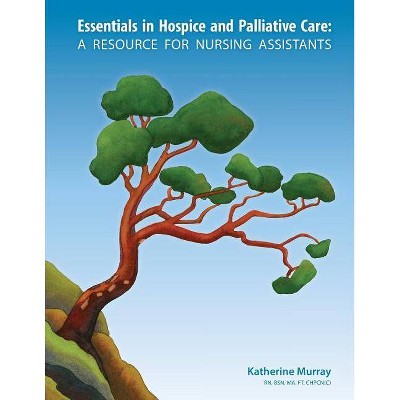Handbook of Pain and Palliative Care - by Rhonda J Moore (Paperback)

Similar Products
Products of same category from the store
AllProduct info
<p/><br></br><p><b> About the Book </b></p></br></br><p>While chronic pain sends millions to the doctor every year, their treatment remains less than adequate. This book adopts 'biobehavioral' and 'lifespan' approaches on the issue, exploring chronic pain and the interventions that physicians can use to relieve it.</p><p/><br></br><p><b> Book Synopsis </b></p></br></br>A Biopsychosocial Approach to Understanding Chronic Pain and Disability.- Part I: Communication and Pain.- Pain and Intercultural Communication.- Truth telling and Palliative Care.- Communication and Palliative Care: E-health Interventions and Pain Management.- Educating Patients and Caregivers about Pain Management: : What clinicians need to know.- Part II: Assessment.- Pain Assessment Tools in Palliative Care and Cancer.- Quality Indicators for Pain in Palliative Care.- Palliative Care Clinical Trials: Generalizability and Applicability in Hospice and Palliative Care Practice.- Dynamic Pain Assessment: An Application of Clinical Infometrics to Personalized Pain Treatment and Management.- Assessing Pain and Unmet Needs in Patients with Advanced Dementia: The Role of the Serial Trial Intervention (STI) .- Part III: Common Pain Conditions.- Pediatric Chronic Pain.- Pain in the Older Person.- Pain After Traumatic Brain Injury.- Pain in the Battlefield Injured.- Pain, Whiplash Disorder and Traffic Safety.- Chronic Low Back Pain.- Adult Cancer-Related Pain.- Part IV. Mechanisms.- Neuroanatomy of Pain and Pain Pathways.- Acute to Chronic Pain: Transitions in the Post Surgical Patient.- Pain and the Placebo/Nocebo Effect.- Sex Differences in Pain across the Life Course.- Stress and Pain.- Hope in the context of pain and palliative care.- Temporomandibular Disorders and Fibromyalgia.- Phantom Limb Pain.- Pharmacogenetics of Pain: the Future of Personalized Medicine.- Pain Imaging.- Part V. Interventions.- Evidence-based Pharmacotherapy of Chronic Pain.- Chronic Pain and Opioids.- Nerve Blocks, Trigger Points, and Intrathecal Therapy for Chronic Pain.- Neurosurgical Interventions for the Control of Chronic Pain Conditions.- Rehabilitation Treatments for Chronic Musculoskeletal Pain.- Part VI: Psychosocial, Complementary and Alternative (CAM) and Spiritual Approaches for the Control of Symptoms.- Pain, Depression and Anxiety in Cancer.- Support groups for Chronic Pain.- CAM in Chronic Pain and Palliative Care.- Spiritual Dimensions of Pain and Suffering.- Part VII: Perspectives from the Humanities and Social Sciences.- Suffering, Hope, and Healing.- Narrative and Pain: Towards an Integrative Model.- Representations of the Body in Pain: Anthropological Approaches.- The Art of Pain: the Patient's Perspective of Chronic Pain.- Part VIII: Ethical Issues and Future Directions.- Disparities in Pain Management and Palliative Care.- The Delineation and Explication of Palliative Options of Last Resort.- Recognition and Resolution of Ethical Barriers to Palliative Care Research.- How Health Care Reform can Improve Access to Quality Pain and Palliative Care Services.<p/><br></br><p><b> From the Back Cover </b></p></br></br><p>This book takes both a biobehavioral and a lifespan approach to understanding long-term and chronic pain, and intervening to optimize patients' functioning. Rich in clinical diversity, chapters explore emerging areas of interest (computer-based interventions, fibromyalgia, stress), ongoing concerns (cancer pain, low back pain), and special populations (pediatric, elderly, military). This coverage provides readers with a knowledge base in assessment, treatment, and management that is up to date, practice strengthening, and forward looking. Subject areas featured in the Handbook include: </p><p> ▪ Patient-practitioner communication</p><p>▪ Assessment tools and strategies</p><p>▪ Common pain conditions across the lifespan</p><p>▪ Biobehavioral mechanisms of chronic pain</p><p>▪ Pharmaceutical, neurological, and rehabilitative interventions</p><p>▪ Psychosocial, complementary/alternative, narrative, and spiritual approaches</p><p>▪ Ethical issue and future directions</p><p> With the rise of integrative perspective and the emphasis on overall quality of life rather than discrete symptoms, pain management is gaining importance across medical disciplines. <i>Handbook of Pain and Palliative Care</i> stands out as a one-stop reference for a range of professionals, including health practitioners specializing in pain management or palliative care, clinical and health psychologists, public health professionals, and clinicians and administrators in long-term care and hospice.</p><p> </p><p> </p><p><p/><br></br><p><b> Review Quotes </b></p></br></br><br><p>From the reviews: </p><p>Rich in clinical diversity, chapters explore emerging areas of interest (computer-based interventions, fibromyalgia, stress), ongoing concerns (cancer pain, low back pain), and special populations (pediatric, elders, veterans). This coverage provides readers with a knowledge base in assessment, treatment, and management that is up-to-date, practice-strengthening, and forward-looking.</p><p></p><p><i>Currents Pain Management News and Research, The e-Newsletter of the American Academy of Pain Medicine</i></p><p><br><p/><br></br><p><b> About the Author </b></p></br></br>Rhonda Moore, PhD received her doctoral degree in cultural and medical anthropology from Stanford University and completed her post-doctoral fellowships in behavioral science from Stanford Medical School and in epidemiology at the University of Texas M.D. Anderson Cancer Center. Dr. Moore has edited two other books for Springer: Cancer, Culture and Communication (2004) with David Spiegel, MD (Stanford School of Medicine) and Biobehavioral Approaches to Pain(2009).
Price History
Price Archive shows prices from various stores, lets you see history and find the cheapest. There is no actual sale on the website. For all support, inquiry and suggestion messages communication@pricearchive.us




















